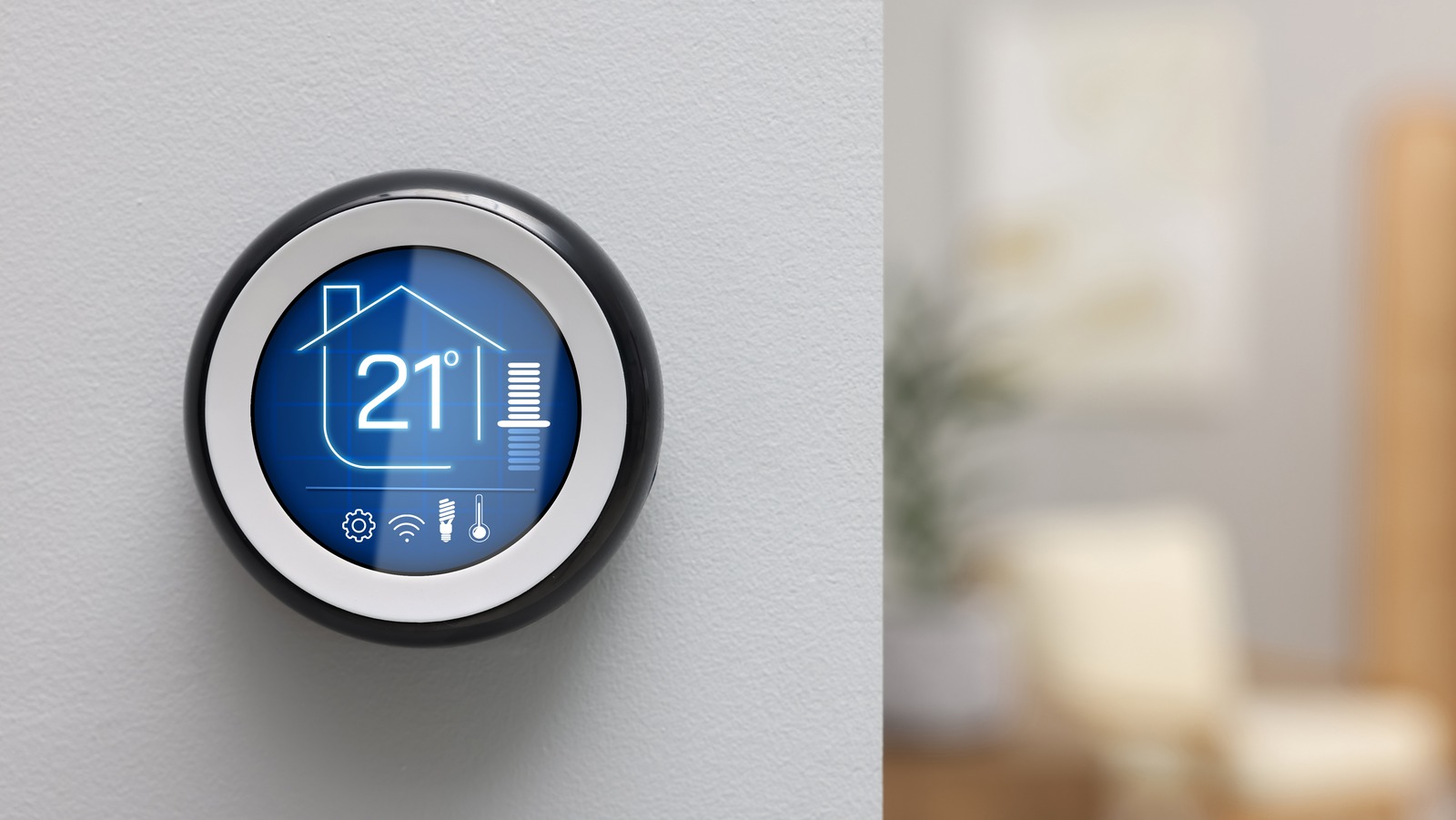Tech
Major Smart Thermostat Brands Ranked Worst To Best – SlashGear

We may receive a commission on purchases made from links.
Smart thermostats are taking off in a big way. They’re larger — and easier to read and use — than traditional thermostats, while also coming with a bunch of extra features. They’re so useful that utility companies are recommending people get them so they can use the smart functionality to reduce energy demand. That’s why anyone who has their heating, ventilation, and air conditioning system replaced in the near future will no doubt hear the technician pitch a smart thermostat in addition to the installation.
Advertisement
Potential buyers, though, have tons of options to choose from. They all perform the basics, like allowing you to adjust your temperatures, set schedules, and view or adjust your home’s temperature from your smartphone while you’re not there. After that, brands have a bunch of extras you can choose depending on what you want. Not only do smart thermostats add tons of functionality over their dumber siblings but they can also lower your energy bill and are generally not difficult to install, among the reasons to add a smart thermostat to your home.
So which one should you get? Here we’ll tell you about each major brand and how it ranks compared with other brands. There also are some smaller players like Cync, Commercial Electric, and Tekmar, but they’re far from being major players in this space. We’ll say more about our methodology at the end of this story.
Advertisement
11. Aprilaire
You’re more likely to see the Aprilaire name at your local Home Depot than you are anywhere else, as the brand is best known for its whole-house humidifiers. Aprilaire also offers a handful of thermostats, and a few of them are smart. The smart models include the 8920W, 8910W, 8620W, and S86WMUPR. For the most part, Aprilaire products have one of two looks. The first is a minimal look with few graphics and simple controls while the other looks like a command center for your HVAC system.
Advertisement
Generally speaking, Aprilaire products work pretty well. Consumer Reports rates them a three out of five while dinging the brand for not having the best automation on the block. The higher-end models come with Amazon Alexa and Google Assistant controls with Apple HomeKit being notably absent. In addition to thermostat stuff, Aprilaire boasts controls for other parts of the HVAC system too, including humidity controls and other stuff if you have them installed. The only downside is that the humidifier, air cleaner, and other tech have to be from Aprilaire. Otherwise, the smart thermostat only controls your house temperatures.
Locking a product down to a brand’s own products isn’t intrinsically bad. However, it makes it difficult to recommend the brand since you have to use its other products. Plus, these thermostats can get expensive, with the Aprilaire 8920W going for $449.99 on Amazon when not on sale. They’re okay if you use Aprilaire throughout your house, but otherwise, you can do better.
Advertisement
10. Trane
Trane is not the first thought when it comes to smart thermostats. While the brand does sell them, you’re more likely familiar with its lineup of furnaces and air conditioners. Trane’s smart thermostats come in five flavors — the ComfortLink II XL850, ComfortLink II XL1050, Link UX360, XL824, and XR724. Each has a utilitarian look that may or may not fit well with your home’s decor, but the big, colorful touchscreens impart plenty of information regardless of which model you buy.
Advertisement
Trane thermostats are rated fairly well on Consumer Reports and by user reviews. Most are readily available on Amazon as well, letting users buy and install them without Trane’s assistance. Consumer Reports praises their manual controls but knocks them a bit as they don’t have as much automation as the larger smart thermostat brands. They also support Google Home and Alexa while also being able to connect to Z-Wave devices.
Additionally, Trane thermostats have built-in functionality for Trane HVAC systems. This is where the caveat kicks in. As with Aprilaire, you’ll need to migrate your entire system to use Trane if you want to use all of the thermostat’s features. Since Trane thermostats can range up to $599 on Amazon for the highest-end ComfortLink II XL1050, they’re great if you already have a compatible Trane HVAC system in place to use all the features. Otherwise, we recommend looking elsewhere.
Advertisement
9. Bosch
Bosch is a well-known player in heating and cooling. The company makes furnaces, air conditioners, water heaters, and air purifiers. It also makes two smart thermostats, the BCC100 and BCC110 models. You’ll most likely want to pick the BCC110, which actually costs less than its slightly inferior counterpart. They look virtually identical with white borders and 5-inch touchscreens. The main difference is that the BCC110 seems to have better support for smart-home services like Alexa and Google Home, and better support for most HVAC systems.
Advertisement
In general, Bosch’s options are fairly solid. You get the aforementioned smart-home support along with smartphone control via Bosch’s app. The on-screen controls are big and fairly easy to follow for smart thermostat beginners while the app control is decent. Consumer Reports dings the Bosch thermostats for having hardly any automation, which is understandable: You can do regular scheduling and not much else, so it’s not the smartest smart thermostat on the block. The biggest feature with Bosch thermostats is that you can connect other thermostats to control larger spaces with more accuracy.
Like Trane and Aprilaire, Bosch thermostats are on the more expensive side. The Bosch BCC110 costs $189 on Amazon. Unlike Aprilaire and Trane, you don’t necessarily need Bosch HVAC components to get the most out of these thermostats, making them a better option for a wider range of people.
Advertisement
8. Vine
Vine isn’t the biggest name in thermostats, but the company sure does make a lot of them. As of this writing, Vine has six smart thermostats to choose from — the ST300, TJ-919T, TJ-560, TJ-550, TJ-919E, and the TJ-610E. Unlike most brands, Vine switches it up a lot when it comes to design, some being full-screen experiences while others — the TJ-610E, TJ-550, and the ST300 — have a mixture of touchscreen and physical controls. That makes it much easier to mix old school with new school if you don’t want to go fully digital for your thermostat.
Advertisement
Consumer Reports notes the same pros and cons as it does with Aprilaire and Trane. Vine gets high marks for its manual operation thanks to the physical controls on many of the thermostats. However, these are on the dumber side of the smart home. You get the usual stuff like smartphone control via the app and scheduling but there isn’t any automation to speak of. They’re essentially just normal thermostats with smartphone controls. On the plus side, they do support Amazon Alexa, Google Home, and Apple HomeKit, putting them a step above many competitors.
Vine thermostats are also relatively inexpensive. The TJ-610E goes for $75 on Amazon while the Vine TJ-560 costs $110 and the TJ-550 will run you $80. Overall, the brand is decent, and the physical controls are not common. However, if you want a smarter thermostat, you’ll need to pick another brand.
Advertisement
7. Amazon Smart Thermostat
Amazon makes one thermostat and somewhat surprisingly, it’s not part of the Ring brand. It features a very plain all-white design with three touch buttons along the bottom and a simple display that shows the current temperature. For the most part, you won’t be looking at or using the thermostat itself, instead relying on the Amazon Alexa app to do all the work for you. Thus, it’s apropos that it’s an entirely white box that mostly blends in with the wall behind it, assuming your walls are white.
Advertisement
As stated, you’ll control this thing from the Amazon Alexa app the vast majority of the time. Since it’s an Amazon product, it doesn’t have compatibility with Google Home or Apple HomeKit, but that’s not unexpected. In addition to its base functionality, it also works with Amazon products that house temperature sensors, including the 4th and 5th generation Echo Dot and the Amazon Smart Air Quality Monitor. Otherwise, this is similar to earlier thermostats on the list. You can set schedules and control the temperature from your smartphone, but Amazon didn’t include any automation functions like geofencing.
The benefit of the Amazon Smart Thermostat is that it integrates with an existing Alexa setup without much hassle, but you can get more if you go with a different brand. At the very least, the Amazon Smart Thermostat is among the least expensive on the list, costing $80.
Advertisement
6. Wyze
Wyze, like Vine, isn’t well known in the smart thermostat space but the sole Wyze smart thermostat is actually quite good. It’s an unadorned vertical design with a screen on top and a control knob on the bottom. The display is also quite simple, showing mostly just the temperature unless you dives into the settings menu. It’ll turn orange when the heat is on and blue when the air conditioning is on, giving users a simple way to tell which system is on and running.
Advertisement
It checks the usual boxes, including smartphone app support along with support for Amazon Alexa and Google Home. Unlike every thermostat thus far, Wyze’s offering has some automation features you can engage with. That includes automatically turning on the heat to keep plumbing from freezing, a motion-sensing comfort mode that detects what room you’re in and adjusts the thermostat accordingly, and monthly usage reports to show you how much energy you’re using. You can also pair it with other Wyze smart-home tech. For example, you can have the motion detection work when a connected camera detects movement outside.
Despite being the first thermostat on the list that does more than the basics, the Wyze Smart Thermostat is still among the least expensive options at just $78 on Amazon. The design is a little polarizing, but the features work pretty well, especially if you already use Wyze tech in your smart-home setup.
Advertisement
5. Cielo
Cielo and Wyze are similar in that their thermostats are a step up in terms of intelligence from the basics. Cielo also sells more varieties than Wyze. Currently, Cielo has two smart thermostats, the appropriately named Smart Thermostat and the Smart Thermostat Eco. In addition, Cielo sells mini-split controllers that function as smart thermostats even if they’re technically just mini-split controllers. We mention them here because the Cielo Breez Max and Breez Plus bake in smart thermostat features like geofencing along with mini-split features like anti-freezing. For mini-splits, Cielo is your best bet.
Advertisement
For actual thermostats, Cielo does pretty well. It does the basics like you would expect, with Amazon Alexa and Google Home support along with an app to control things when you’re not around. Ceilo also boasts Samsung SmartThings, Siri, and IFTTT compatibility. It also comes with a healthy dose of automation in the form of geofencing. The smartphone app will detect your general location. It’ll then set the temperature and have your home heated or cooled by the time you get home. There is also a vacation mode that’ll run your system less often to save money when you’ll be gone for a few days.
There are only small differences between the regular Smart Thermostat and Eco models, with the big difference being whether you want to display the weather. The regular Cielo Smart Thermostat costs $130 on Amazon while the Eco goes for $100.
Advertisement
4. Honeywell
Honeywell is one of the biggest names in thermostats, having made the first consumer-facing thermostat back in 1906. Today, the brand leans into its heritage by offering tons of thermostats. In terms of smart thermostats, Honeywell has two main product lineups. The first is the T-series, which includes the T10+, T9, T6, and T5. The other is the Wi-Fi lineup, which includes the Wi-Fi Smart Color Thermostat, Wi-Fi 9000, and the Wi-Fi Smart Thermostat. Of the two, the T-series is the more advanced lineup and the ones that both consumers and Consumer Reports prefer.
Advertisement
The T-series offers a bunch of features that scale up depending on which model you get. At the top end, you have the T9 and T10+ thermostats. They both offer the usual stuff like smartphone control and support for all major smart-home setups. When properly equipped with additional sensors, the T9 and T10+ know which room of the house you’re in and can adjust the thermostat automatically. There is also geofencing, giving you plenty of automation controls on top of the usual smart stuff.
The T9 and T10+ have the best reviews of Honeywell’s products so those are the ones we recommend. You can get the Honeywell T9 for $210 on Amazon and the T10+ for $230.
3. Sensi by Emerson
Sensi, a subsidiary of Emerson, has two delightfully functional thermostats. They are the Sensi Touch 2 and the Sensi Lite. The two look very similar when viewed side by side. Both are black slabs with touchscreens equipped. The Touch 2 has the larger and more colorful touchscreen, so those who want full functionality will likely choose that one.
Advertisement
On top of the usual smartphone controls, Sensi packs quite a bit of automation into its thermostats, even the less expensive Lite. That includes geofencing, which is a surprising feature at a sub-$100 price. You also get usage reports and other things like maintenance reminders to make sure your HVAC system is running as optimally as it can. In short, Sensi thermostats can do what more expensive options can while also keeping the costs down. There are even Sensi-compatible sensors in case you want whole-home monitoring as well.
The Sensi Lite costs $90 on Amazon while the Touch 2 goes for $140. There is a white-beveled version of the Touch 2, but it’s priced at $70 more. Considering the features, these are very reasonable prices, and reviewers agree that Sensi makes some pretty good thermostats overall.
Advertisement
2. Google Nest
Google Nest is one of the big dogs when it comes smart thermostats and it’s among the best, according to Consumer Reports. Google makes two thermostats, the regular Google Nest Thermostat and the more powerful Google Nest Learning Thermostat 4th Gen. The former has a simpler design, with Google’s hallmark round screen with a screen that shows you information. The more expensive Learning Thermostat has a similar design but with more curves and flourish to let you know that it’s the more premium product.
Advertisement
When it comes to smarts, the Google Nest Learning Thermostat is where it’s at. It can use room sensors to dial in the perfect temperature for your home while offering a range of automations, including a machine learning feature that figures out what temperatures you like and when, then automatically sets the temperatures throughout the day. Thus, it effectively programs itself over time, removing the need for you to do anything once it learns what you like. Google automates the thermostat in other ways as well, making it arguably the smartest thermostat on the market.
That automation comes at a cost. The regular Google Nest Thermostat costs $130 while the Learning Thermostat ups the ante to $280.
Advertisement
1. Ecobee
Ecobee tops the list with three very effective thermostats. They include the Ecobee3 Lite, Ecobee Enhanced, and the Ecobee Premium thermostats. The Ecobee3 Lite has been around for a while and represents the lowest-cost option. It comes with limited automation but rock-solid performance all around, including support for Ecobee room sensors. I have owned this thermostat since 2019 and after five years of ownership, I can tell you that it’s pretty good.
Advertisement
Ecobee’s more powerful thermostats add more. The Enhanced and Premium add things like an Eco+ mode that acts as the brand’s geofencing feature while also including some learning capabilities such as remembering when you are and aren’t home. Thus, you get more automation than with most brands but not quite as much as the Google Nest. It’s a good mixture of features. Ecobee’s app also mirrors its thermostat user interface, so once you learn how to use it, it works the same at home or on the smartphone.
The Ecobee3 Lite starts at $150, which is fairly expensive for a low-end model. For $40 more, you can get the Ecobee Enhanced thermostat, while the top-of-the-line Premium thermostat goes for $250.
Advertisement
How we ranked these thermostat brands
We used a variety of metrics to rank these thermostat brands. For the base, we used Consumer Reports, and then we augmented the list based on user reviews, professional reviews, and, in the case of Ecobee, personal experience. So, for example, Honeywell had some of the highest-rated thermostats on the list. However, some of its lower-tier models didn’t review very well. Meanwhile, Google Nest and Ecobee have almost unanimously positive reviews on all their products, so they were placed higher than Honeywell.
Advertisement
In addition, we took availability, selection, and feature set into account. Aprilaire and Trane sell thermostats, but they also require the user to own Aprilaire and Trane products to use all the features, which makes it harder for consumers to use them to their maximum. Meanwhile, Amazon, Wyze, and Bosch all essentially have a single product. Cielo and Vine have plenty of good, unique products but they aren’t as powerful as ones from Honeywell, Google, and Ecobee. Once these metrics were all plugged in, the above list popped out.










